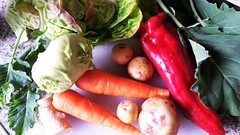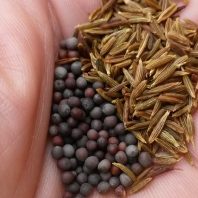Kitcheri is Indian fast food – old school. It’s a one pot dish with full nutrition: veg, rice and dhal. Simple and tasty comfort food, it’s a dish that all vegans and vegetarians would do well to add to their repertoire. It gives the grain-legume full amino acid complement. It’s a bit like making risotto because you add water to the grains as they plump. With this stirring and the chopping prep, a nice chance to practice mindfulness and mantra repetition and so add the essential ingredient: love.
In the hand you can see the classic spicing: mustard seeds and cumin seeds. These are heated in oil at a high temperature ’til they pop, so releasing the aromatic compounds that make the dhal easily digestible. I love the smell of popping mustard seed. It means good food is on the way.
The dhal is split mung beans, the most easily digestible of all dhals. Because the dish is so easily digestible and light overall, and a little bit plain, it’s considered a fasting and purifying food, as well as convalescent. Ayurvedic medicine makes use of it to deliver healing spices, such as cloves. Ghee, the traditional base, draws toxins out of the body and soothes the nerves/nadis but the vegan version with a good oil is effective too.
Kitcheri is not so photogenic but still a beautiful dish. I recently made it for a retreat group who loved it; this is for you, bam namah.

Ingredients (for 4)
- 4 tablespoons oil high-ish smoke point; rapeseed, sunflower or coconut, for instance
- 1 teaspoon black mustard seeds don’t be tempted to use more as they are very heating and can cause a bit of an upset
- 1.5 teaspooncumin seeds try to get fresh, organic spices for best results – I like Bart Spices, for instance
- 4 or 5 pieces of flaked chilli (ie not very much at all) or experiment with a small amount of bird eye chilli
- a thumb of ginger (ie about 6-8 cubic cm) peeled and grated
- 150g split mung dhal can be polished and yellow, or with the green skin still on – both usually available in Asian grocers’
- 150g organic basmati rice white or brown, brown takes a bit longer to cook but is extra delicious and with B vitamins
- 300g mixed veg chopped good to have a mix of colours and roots/fruits. Always carrots; also for instance, potatoes, kohl rabi, fennel, French beans, broad beans, peppers, aubergine, tomato. Choose what is fresh and available
- kettle of boiled water on standby
- 2 tsp ground turmeric
- a good handful of fresh green leaves, shredded about 1cm wide spinach, kale, chard, cabbage for instance
- 1tsp salt (to taste)
- juice of 1 lemon
- big handful of washed and chopped coriander
Method
- Put the dhal and rice in a bowl with water and rinse 2 or 3 times, swirling. You will see starch run out. No need to get rid of it all, you’d be there all day anyway. Then cover with an amount of water and let the grains rest in it.
- Prepare the veg, cutting into uniform pieces, sort of just under a cubic centimetre. You may want to keep the denser (ie carrots and roots) from the lighter so you can fry them off in turn – see step 4.
- Put the oil, seeds and chili flakes in a medium pan with a solid bottom. Heat the oil hard. This section requires you to hold your nerve a little bit. At a certain point the seeds pop. Add the grated ginger and stir with a wooden spoon for 15 seconds or so. It’s all spitting and you think it’s burning, but keep stirring and it won’t burn. This stage is important to release all the good aromatic compounds.
- Tip in the harder veg and cover in the oil and spices. Move them about once the heat regains for four or five minutes, then add the softer veg. Move them about and when the pan is hot again, drain the rice and dhal and add them. Stir about, ensuring everything is covered in some oil for another few minutes.
- The grains might stick a bit to the pan, stir a bit more but when it seems a losing battle pour in water from the kettle to just cover the pan contents. TAKE CARE! hot water may spurt up. Keep stirring over a medium heat, and as the grains absorb the water, add more from the kettle.
- When you pick out a piece of mung and it squashes tenderly, and there’s a shallow glazed puddle of water on the top, add the sliced greenery and turn it in lightly to the mix. Turn off the heat and put on a lid. Allow the pot to sit for 5 minutes. Time to lay the table and call the troops.
- Add the salt, lemon juice and coriander. Stir. If you can, while final faffing and meal prayer go on, let it sit for another 5 minutes
- Serve with a mixed salad, and/or with my favourite, roast fennel, but could be any roast veg (beetroot, carrots, squash, courgettes), and date and ginger chutney. Recipes for other fresh chutneys are coming…
